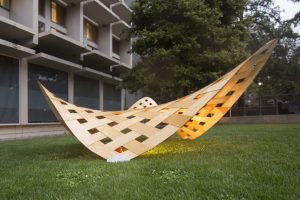Lunch @UCBerkeley with Simon Schleicher – Flexible architecture: Learning from nature’s soft and compliant structures
Lunch @UCBerkeley with Simon Schleicher – Flexible architecture: Learning from nature’s soft and compliant structures

In architecture, kinetic structures like movable blinds and louvers enable buildings to react to internal and external stimuli through spatial adjustments. While these mechanical devices come in all dimensions, they are conceptualized as uniform and standardized modules. Typically, they gain their movability by connecting rigid elements with highly strained hinges. Even though this construction principle may be generally beneficial, it has some major drawbacks for architectural applications. Adaptation to irregular facade geometries, for example, can only be achieved with additional mechanical complexity, which makes these devices often very expensive, prone to failure, and maintenance-intensive.
In his research, SimonSchleicher is searching for a promising alternative to the persistent paradigm of rigid-body mechanics and has found inspiration in flexible plant movements. By using modern computational modeling and advanced simulation techniques, he can reveal the plants’ compliant mechanisms and integrate their underlying physical principles in bio-inspired flexible structures. In various case studies, he demonstrates the transfer process in more detail and shows how bio-inspired mechanisms render the possibility for a new type of flexible architecture in the future.

